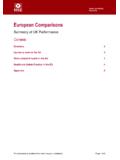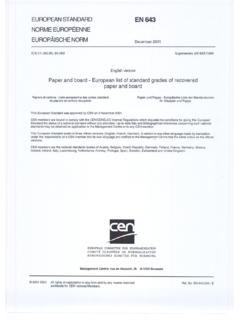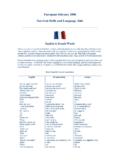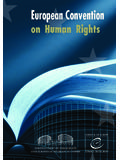Transcription of European seagrasses: an introduction to …
1 Data sheet: Title: European seagrasses : an introduction to monitoring and management Editors: J Borum, CM Duarte, D Krause-Jensen and TM Greve Publisher: The M&MS project Date of publication: September 2004. ISBN: 87-89143-21-3. Internet version: Available at Copyrights: This book is freely available and can be copied with no charge. Photos and graphs may be protected by copyright and cannot be used in other publications without prior permission. European seagrasses : an introduction to monitoring and management A publication by the EU. project monitoring and Managing of European seagrasses (M&MS).
2 EVK3-CT-2000-00044. Edited by Jens Borum, Carlos M. Duarte, Dorte Krause-Jensen and Tina M. Greve ii European seagrasses : an introduction to monitoring and management A publication by the EU. project monitoring and Managing of European seagrasses (M&MS). EVK3-CT-2000-00044. Edited by Jens Borum, Carlos M. Duarte, Dorte Krause-Jensen and Tina M. Greve iii Data sheet Title: European seagrasses : an introduction to monitoring and management Editors: J Borum, CM Duarte, D Krause-Jensen and TM Greve Publisher: The M&MS project Date of publication: September 2004. ISBN: 87-89143-21-3.
3 Internet version: Available at Copyrights: This book is freely available and can be copied with no charge. Photos and graphs may be protected by copyright and cannot be used in other publications without prior permission. iv Preface By Jens Borum (FBL), Carlos M. Duarte (IMEDEA), Dorte Krause-Jensen (NERI) and Tina M. Greve (FBL). seagrasses are rooted, flowering plants that grow in the marine environment with great success. seagrasses form dense and highly productive beds of great importance to invertebrates, fish and many birds, and the beds provide protection against coastal erosion.
4 The four European seagrass species grow from the intertidal and down to 5-15 meter depth in North European waters (Zostera marina, Z. noltii), but seagrasses may be found even deeper than 50 meter in clear Mediterranean waters (Cymodocea nodosa and Posidonia oceanica). In the Mediterranean Sea, P. oceanica beds cover between 25,000 and 50,000 km2 of the coastal areas corresponding to 25%. of the sea bottom at depths between 0 and 40 m. Hence, seagrasses are extremely important components of coastal European waters. Seagrass beds are, however, also vulnerable and have declined substantially in many coastal areas due to increasing human pressure in the form of nutrient loading, siltation and mechanical disturbance.
5 Several countries within the European Union have national legislation and regulations to protect seagrass beds from anthropogenic disturbance, but with the Water Framework Directive the Member States have established a mutual platform and obligation to ensure a good ecological status . corresponding to conditions with minimal anthropogenic impact of all surface waters. Extended seagrass beds with a good penetration to deep waters are characteristic of coastal waters with minimal anthropogenic impact. Since seagrasses are mostly perennial organisms, they reflect the temporally integrated environmental conditions, and, therefore, seagrasses are excellent indicator organisms on which environmental monitoring and management of coastal waters can focus.
6 Hence, there is a high need for efficient monitoring and management strategies for the European seagrass species, and we hope that the present booklet will strengthen the focus on these unique coastal organisms. With this booklet, we aim to give environmental managers a basic introduction to monitoring and management of European seagrasses . Several countries already have established comprehensive and advanced monitoring programmes for seagrasses , but in many European countries programmes are virtually absent. We here, primarily, target the latter group by compiling and presenting basic information on what seagrasses are, what their importance is, the factors controlling their performance, the threats against them and the temporal scales for seagrass recovery.
7 Next, we introduce the reader to basic monitoring strategies and parameters, and, finally, we present recommendations as to how seagrass beds can be protected and recovered through environmental management . If coastal managers on this basis decide to initiate monitoring and management programmes for seagrasses , they will need more detailed information than provided by this booklet. Hence, we have listed links and references to existing seagrass monitoring programmes, manuals on seagrass monitoring and a number of relevant scientific papers. The booklet is an outcome of a joint EC-funded project (EVK3-CT-2000- 00044) entitled monitoring and management of European Seagrass Beds v (M&MS) under the 5th Framework Programme.
8 The partners involved in the project and contributing to this booklet are: Freshwater Biological Laboratory, University of Copenhagen, Denmark (FBL). Dept. of Marine Ecology, National Environmental Research Institute, Denmark (NERI). School of Ocean Sciences, University of Wales, United Kingdom (SOS). Centro de Ci ncias do Mar, Universidade do Algarve, Portugal (CCMAR). Parque Natural da Ria Formosa, Instituto da Conserva o da Natureza, Portugal (PNRF). Instituto Mediterraneo de Estudios Avanzados, Consejo Superior de Investigaciones Cientificas, Spain (IMEDEA). Direcci General de Pesca, Govern de Les Illes Balears, Spain (DGP).
9 The objective of the project has been to conduct research on European seagrasses with respect to their dependence on water and sediment quality, their capacity for spreading and expansion through vegetative propagation and sexual reproduction, and their response to environmental conditions as reflected by genetic diversity and isotopic composition. The results are - and will be - published in scientific journals but they are also, combined with knowledge from the literature, the foundation for this booklet. More information about the project is available on the project home page ( ) from where the booklet can be downloaded in pdf format.
10 Acknowledgements We are indepted to Jan E. Vermaat, Jens S. Laursen, Sif Johansson, Nuno Grade and Elvira A. P rez for their contributions as external and internal reviewers providing constructive critique and comments on the structure of the book and on drafts of chapters. vi Contents The four European seagrass species 1. Jens Borum and Tina M. Greve Why are seagrasses important? Goods and services provided by 8. seagrass meadows Jorge Terrados and Jens Borum How do seagrasses grow and spread? 11. N ria Marb , Carlos M. Duarte, Ana Alexandre and Susana Caba o Which factors regulate seagrass growth and distribution?





